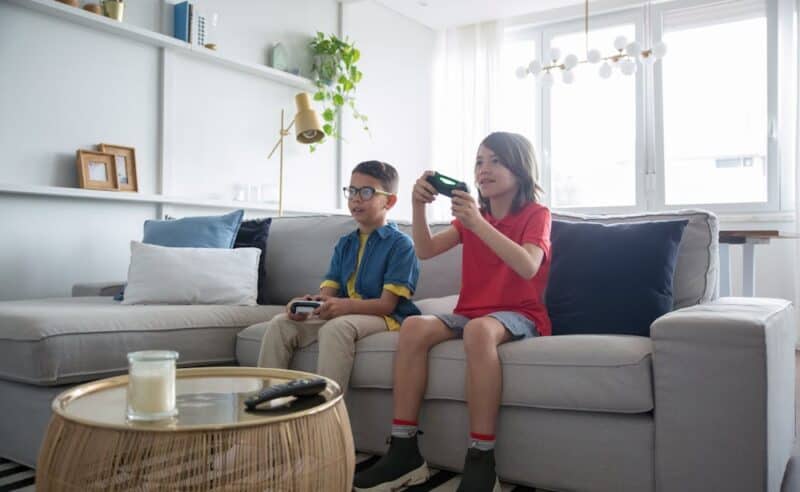It’s no secret that many young children enjoy video games. In fact, it’s been shown that children of a certain age in our current year want to play more video games than they want to watch television. Unfortunately, that also means they wish for this more than they hope to read books.
This brings up an interesting parental quandary. While video games are much less harmful than assumed, it’s true they can cause behavioral addictions, expose children to unsuitable content if not carefully managed, and may also replace good habits without screentime.

For that reason and many more, parents must decide how they allow video games in their household and what parameters they set for their use. This doesn’t mean you have to ban them outright – they can be great fun, and you can get involved too – but it does mean setting limits, keeping an eye on the games being played and the conduct of your child online (as many consoles and of course desktop computers connect). After all, who hasn’t played a cheeky session of Minesweeper during their lunch break? We’d all be a little hypocritical to dismiss gaming entirely.
While the title of this post makes it seem like you should follow set instructions, we’ll offer a few suggestions below you can then use to make your own choices. After all, all parents adhere to these requirements differently. Let’s consider the options below:
Set Time Limits
Reliability is often the name of the game here. Perhaps you let your child have two hours of screen time a night, and only after they’ve performed their homework and completed their chores. Maybe that could extend to the weekend.
But at the same time, investing in their outside hobbies, such as a school sport or learning a musical instrument, can help balance this. Ultimately, helping your child grow interests outside of the game console can lessen their constant need to play it. A time limit can also prevent tantrums or arguments (at least, that’s the goal) because your child knows exactly what is expected of them. Better yet, parental controls can shut down use outside of conventional hours.
Choose Age-Appropriate Games

Did you know that if you set up parental controls on a game console, you can define the age rating of the video games played on it? So if your thirteen-year-old brings home a mature-rated game, due to the restricted content rating, the video game won’t play on the console.
This can be very helpful and even provide parents with a little wiggle room for the kind of content they’re happy with. You might not find cursing in a game to be so terrible, but of course, violence and graphic depictions of injuries aren’t appropriate. Luckily, no game developer is trying to trick you regarding the content within, so reading the boxes or digital information sheets can be helpful.
With the uptake of classic retro games, we’ve seen a surge in retro-inspired indie games from re-releases to remakes and modern recreations. The great news here is that you’re able to access games that follow a simple winning formula, are challenging and fun but without gore or adult content. Retro inspired games offer a broader appeal so before you know it the whole household will be competing and chatting about how they beat the boss or their favourite level. This leads us to retro games. They are simple, fun, super affordable and can be played on your phone, computer, or a dedicated retro gaming console with no internet connection – keeping things simple and ensuring your child is in a safe environment.
Consider Creative Games
Many of us have the idea that games are just about conflict, fighting, and war. But that’s not the case at all. In fact, a growing number of games, especially those in the “cozy” genre, have fantastic and comfortable depictions of relaxing topics within. For example, Stardew Valley is known to be one of the best farming simulators with a fun, accessible twist, while Disney Dreamlight Valley encourages crafting and building your own home.
Creative games like Minecraft are a phenomenon, and allow you to build whatever you find interesting, such as castles, houses, villages, and more. You can veer away from the violence and encourage creativity, building, and even a story focus. As ever, it’s not games that are bad or good in general, it’s those that are most suitable for a child’s developing mind that are worth appreciating.
Play Together As A Family

Gaming doesn’t solely have to be “something the kids do.” It can be a fun event for the whole family. With silly party games such as Mario Party, you can come together, compete, co-operative, and have a blast. Some games even have wonderful stories worth playing through together, making decisions, and moving forward with confidence.
Playing together as a family is also a good way to make the console less of a topic of conflict and more something you see as valuable. After all, gaming is just entertainment, not necessarily an addiction, unless bad habits are allowed to fester. Some parents are understandably wary of getting involved or feel frustrated about their child’s enjoyment of games as opposed to getting outside, but there’s no reason to have those antagonistic feelings. With a few good parameters, you can have a great time, too!
With this advice, you’ll be certain to approach video games in the healthiest manner within your household.

